- Home |
- About |
- Contact Us |
- Privacy |
- Newsletter |
- Shop |
- 🔍 Search Site
- Easter Color By Number Sheets
- Printable Easter Dot to Dot
- Easter Worksheets for kids
- Kindergarten
- All Generated Sheets
- Place Value Generated Sheets
- Addition Generated Sheets
- Subtraction Generated Sheets
- Multiplication Generated Sheets
- Division Generated Sheets
- Money Generated Sheets
- Negative Numbers Generated Sheets
- Fraction Generated Sheets
- Place Value Zones
- Number Bonds
- Addition & Subtraction
- Times Tables
- Fraction & Percent Zones
- All Calculators
- Fraction Calculators
- Percent calculators
- Area & Volume Calculators
- Age Calculator
- Height Calculator
- Roman Numeral Calculator
- Coloring Pages
- Fun Math Sheets
- Math Puzzles
- Mental Math Sheets
- Online Times Tables
- Online Addition & Subtraction
- Math Grab Packs
- All Math Quizzes
- 1st Grade Quizzes
- 2nd Grade Quizzes
- 3rd Grade Quizzes
- 4th Grade Quizzes
- 5th Grade Quizzes
- 6th Grade Math Quizzes
- Place Value
- Rounding Numbers
- Comparing Numbers
- Number Lines
- Prime Numbers
- Negative Numbers
- Roman Numerals
- Subtraction
- Add & Subtract
- Multiplication
- Fraction Worksheets
- Learning Fractions
- Fraction Printables
- Percent Worksheets & Help
- All Geometry
- 2d Shapes Worksheets
- 3d Shapes Worksheets
- Shape Properties
- Geometry Cheat Sheets
- Printable Shapes
- Coordinates
- Measurement
- Math Conversion
- Statistics Worksheets
- Bar Graph Worksheets
- Venn Diagrams
- All Word Problems
- Finding all possibilities
- Logic Problems
- Ratio Word Problems
- All UK Maths Sheets
- Year 1 Maths Worksheets
- Year 2 Maths Worksheets
- Year 3 Maths Worksheets
- Year 4 Maths Worksheets
- Year 5 Maths Worksheets
- Year 6 Maths Worksheets
- All AU Maths Sheets
- Kindergarten Maths Australia
- Year 1 Maths Australia
- Year 2 Maths Australia
- Year 3 Maths Australia
- Year 4 Maths Australia
- Year 5 Maths Australia
- Meet the Sallies
- Certificates

Time Worksheets Hub Page
Welcome to our Time Worksheets hub page.
Here you will find links to a wide range of free printable worksheets about Time, which will help your child become more confident telling the time, adding and subtracting time amounts, converting time and solving time word problems.
For full functionality of this site it is necessary to enable JavaScript.
Here are the instructions how to enable JavaScript in your web browser .
- This page contains links to other Math webpages where you will find a range of activities and resources.
- If you can't find what you are looking for, try searching the site using the Google search box at the top of each page.
Time Worksheets
Quicklinks to ...
- Telling the Time sheets
- Time Conversion
Time Puzzles
- Time Calculators
Telling the Time Worksheets
Here is our collection of telling the time worksheets for kids.
The following worksheets involve children telling the time with an analogue clock, and matching analogue and digital times.
O'clock and Half-past
Here is our selection of telling the time worksheets for 1st grade.
Using these sheets will help your child to:
- read o'clock and half-past times;
- convert o'clock and half-past times to digital;
- draw clock hands correctly to mark out o'clock and half-past.
- Telling Time Worksheets o'clock and half past
Quarter Past and Quarter To
Here are our collection of clock worksheets for 2nd grade. These sheets cover telling the time for quarter past and quarter to times.
Using these second grade math worksheets will help your child to:
- read quarter past and quarter to times;
- convert analogue to digital times;
- draw clock hands in the correct place for quarter past and quarter to.
- Clock Worksheets - Quarter Past and Quarter To
Telling the Time to 5 minutes
This section contains our 3rd grade time worksheets to help children tell the time in multiples of 5 minutes.
Using the sheets in this section will help your child to:
- tell the time to the nearest 5 minutes;
- become familiar with both digital and analogue times;
- add and subtract time intervals;
- use the words 'past' and 'to' to describe the time correctly.
These 3rd grade time worksheets will help your child become more familiar with telling the time.
- Telling Time to 5 Minutes Worksheets
Telling the Time to 1 minute
This section contains our 4th grade time worksheets to help children tell the time to the nearest minute.
- tell the time to the nearest minute;
- add and subtract time intervals.
These 4th grade time worksheets will help your child become more familiar with telling the time.
- Telling Time Worksheets Grade 4 (1 minute intervals)
Top of Page
Converting Time
- 24 Hour Clock Conversion Worksheets
On this webpage there is a selection of printable 24 hour (military time) conversion worksheets which will help you learn to convert from 24 hour clock to standard 12 hour time, and from standard time to 24 hour time.
An answer sheet is provided with each sheet and the sheets are graded with the easiest sheets coming with supporting information.
Time Interval Worksheets
These sheets will help you learn to add and subtract hours and minutes from times as well as working out a range of time intervals.
There are also sheets to help you practice adding and subtracting time intervals.
- Add and Subtract Time Worksheets
- Elapsed Time Worksheets
Looking for an extension activity for children who can already tell the time?
Maybe you want an interesting starter activity for your lesson to get the class thinking?
These printable time puzzles will help to get your child thinking about time and solving problems involving time.
They are good at developing an understanding of the language used in time.
- Printable Time Worksheets - Time Puzzles (easier)
- Time Word Problems Worksheets - Harder Riddles
Time Conversion Calculators
Our time calculators will allow you to convert any digital time into a military time, and back.
We also have a decimal time converter which will take a time in hours, minutes and seconds and then convert it to a decimal number which represents that time. This calculator will also take a decimal time and convert it to hours, minutes and seconds.
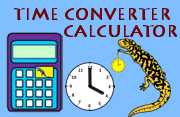
- Units of Time Converter
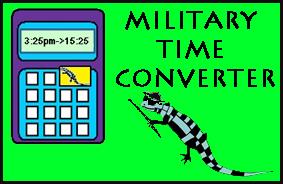
- Online Military Time Converter
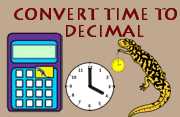
- Convert Time to Decimal
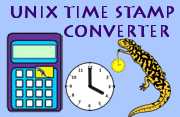
- Unix Time Stamp Converter
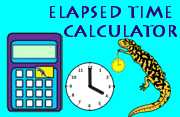
- Elapsed Time Calculator
More Time Calculators
- convert hours to seconds
- hours and minutes calculator
How to Print or Save these sheets 🖶
Need help with printing or saving? Follow these 3 steps to get your worksheets printed perfectly!
- How to Print support
Subscribe to Math Salamanders News
Sign up for our newsletter and get free math support delivered to your inbox each month. Free seasonal math grab pack included.

- Newsletter Signup
Return from Money Printable Worksheets to Math Salamanders Homepage
Math-Salamanders.com
The Math Salamanders hope you enjoy using these free printable Math worksheets and all our other Math games and resources.
We welcome any comments about our site or worksheets on the Facebook comments box at the bottom of every page.
New! Comments
TOP OF PAGE
© 2010-2024 Math Salamanders Limited. All Rights Reserved.
- Privacy Policy
- Copyright Policy
20 Elapsed Time Word Problems
Classen Rafael / EyeEm / Getty Images
- Classroom Organization
- Reading Strategies
- Becoming A Teacher
- Assessments & Tests
- Secondary Education
- Special Education
- Homeschooling
:max_bytes(150000):strip_icc():format(webp)/squareheadshot-5b6da9aec9e77c0050a6e8a5.jpg)
Elapsed time is the amount of time that passes between the beginning and the end of an event. The concept of elapsed time fits nicely in the elementary school curriculum. Beginning in third grade, students should be able to tell and write time to the nearest minute and solve word problems involving addition and subtraction of time. Reinforce these essential skills with the following elapsed time word problems and games.
Elapsed Time Word Problems
These quick and easy elapsed time word problems are perfect for parents and teachers who want to help students practice elapsed time to the nearest minute with simple mental math problems. Answers are listed below.
- Sam and his mom arrive at the doctor’s office at 2:30 p.m. They see the doctor at 3:10 p.m. How long was their wait?
- Dad says dinner will be ready in 35 minutes. It’s 5:30 p.m. now. What time will dinner be ready?
- Becky is meeting her friend at the library at 12:45 p.m. It takes her 25 minutes to get to the library. What time will she need to leave her house to arrive on time?
- Ethan’s birthday party started at 4:30 p.m. The last guest left at 6:32 p.m. How long did Ethan’s party last?
- Kayla put cupcakes in the oven at 3:41 p.m. The directions say that the cupcakes need to bake for 38 minutes. What time will Kayla need to take them out of the oven?
- Dakota arrived at school at 7:59 a.m. He left at 2:33 p.m. How long was Dakota at school?
- Dylan started working on homework at 5:45 p.m. It took him 1 hour and 57 minutes to complete it. What time did Dylan complete his homework?
- Dad arrives home at 4:50 p.m. He left work 40 minutes ago. What time did Dad get off work?
- Jessica’s family is traveling from Atlanta, Georgia to New York by plane. Their flight leaves at 11:15 a.m. and should take 2 hours and 15 minutes. What time will their plane arrive in New York?
- Jordan got to football practice at 7:05 p.m. Steve showed up 11 minutes later. What time did Steve get to practice?
- Jack ran a marathon in 2 hours and 17 minutes. He crossed the finish line at 10:33 a.m. What time did the race start?
- Marci was babysitting for her cousin. Her cousin was gone for 3 hours and 40 minutes. Marci left at 9:57 p.m. What time did she start babysitting?
- Caleb and his friends went to see a movie at 7:35 p.m. They left at 10:05 p.m. How long was the movie?
- Francine got to work at 8:10 a.m. She left at 3:45 p.m. How long did Francine work?
- Brandon went to bed at 9:15 p.m. It took him 23 minutes to fall asleep. What time did Brandon fall asleep?
- Kelli had to wait in a long, slow-moving line to purchase a popular new video game that was just released. She got in line at 9:15 a.m. She left with the game at 11:07 a.m. How long did Kelli wait in line?
- Jaydon went to batting practice Saturday morning at 8:30 a.m. He left at 11:42 a.m. How long was he at batting practice?
- Ashton got behind on her reading assignment, so she had to read four chapters last night. She started at 8:05 p.m. and finished at 9:15 p.m. How long did it take Ashton to catch up on her assignment?
- Natasha has a dentist appointment at 10:40 a.m. It should last 35 minutes. What time will she finish?
- Mrs. Kennedy’s 3rd-grade class is going to the aquarium on a field trip. They are scheduled to arrive at 9:10 a.m. and leave at 1:40 p.m. How long will they spend at the aquarium?
Elapsed Time Games
Try these games and activities at home to help your children practice elapsed time.
Daily Schedule
Let your children keep track of their schedule and ask them to figure the elapsed time for each activity. For example, how long did your child spend eating breakfast, reading, taking a bath, or playing video games?
How Long Will It Take?
Give your kids practice with elapsed time by encouraging them to figure out how long daily activities take. For example, the next time you order a pizza online or by phone, you'll probably be given an estimated delivery time. Use that information to create a word problem that's relevant to your child's life, such as, "It's 5:40 p.m. now and the pizza shop says the pizza will be here at 6:20 p.m. How long will it take for the pizza to arrive?"
Order a set of time dice from online retailers or teacher supply stores. The set contains two twelve-sided dice, one with numbers representing the hours and the other with numbers representing minutes. Take turns rolling the time dice with your child. Each player should roll twice, then calculate the elapsed time between the two resulting dice times. (A pencil and paper will come in handy, as you'll want to jot down the time of the first roll.)
Elapsed Time Word Problem Answers
- 2 hours and 2 minutes
- 6 hours and 34 minutes
- 2 hours and 30 minutes
- 7 hours and 35 minutes
- 1 hour and 52 minutes
- 3 hours and 12 minutes
- 1 hour and 10 minutes
- 4 hours and 30 minutes
- How To Tell Time in Spanish
- Sinking of the RMS Titanic
- A Timeline of the Sinking of the Titanic
- How to Tell Time in Italian
- When Is the Spring Equinox?
- Free Math Word Problem Worksheets for Fifth-Graders
- What Time Is the SAT Test?
- World War II: Operation Ten-Go
- Proportions Word Problems Worksheet: Answers and Explanations
- Telling Time in French
- Building an Effective Plan of Improvement for Teachers
- Learn About the Munich Olympic Massacre
- Fundamental Lessons for Telling the Time
- Practice Multiplication Skills With Times Tables Worksheets
- What Is Uptime in Web Hosting?
- President John F. Kennedy's Assassination
Time and Clock Worksheets
Welcome to the time worksheets page at Math-Drills.com where taking your time is encouraged! On this page you will find Time math worksheets including elapsed time, telling time on analog clocks, calendars and converting time worksheets.
The calendars come in two different formats: yearly (all on one page) and monthly when you need extra space or a larger layout. The calendars are very useful in conjunction with the elapsed time worksheets with days, weeks, months, and years. Students who have difficulty visualizing a calendar may need the actual calendars to use as a reference. Telling time on analog clocks is still an important skill despite the number of digital clocks around; many people still choose the analog clock design for aesthetic purposes.
Most Popular Time and Clock Worksheets this Week
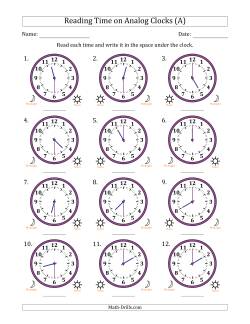
The calendars on this page are meant for anyone to use for purposes including personal schedules, classroom planning, holiday calendars, business meetings, event calendars, or anything else. They can also be used in math activities such as elapsed date activities. A simple activity with the monthly calendars is to ask students to place an item or mark on specific spots on the calendar (e.g. "Place a bean on a Tuesday in March."). After students become familiar with how a calendar is laid out and works, you can create more challenging activities like finding elapsed dates, discovering the number of days in each month, scheduling activities, etc.
Yearly calendars are a great way to see an entire year on one page. Although not easy to write on all your appointments and anniversaries, they are a quick reference and can be very useful when completing math activities to familiarize students with calendars or more advanced activities with calendars.
Specific yearly calendars for the years 2000 to 2050 are available in this section. For any other year or if you want a custom title, you can use the general yearly calendars with fillable titles. There are seven general yearly calendars and seven general leap year calendars in two different formats (Sunday to Saturday and Monday to Sunday) which will cover any year from 1583 on.
- Yearly Calendars (Sunday to Saturday format) Yearly Calendars for Specific Years from 2000 to 2050 (Fillable Title) General Yearly Calendars ✎ (Fillable Title) General Leap Year Calendars ✎
- Yearly Calendars (Monday to Sunday Format) Yearly Calendars for Specific Years from 2000 to 2050 (Monday to Sunday Format) (Fillable Title) General Yearly Calendars (Monday to Sunday Format) ✎ (Fillable Title) General Leap Year Calendars (Monday to Sunday Format) ✎
A great number of math activities can be accomplished with monthly calendars. Familiarization activities include finding specific dates, determining which day of the week it is, marking important events on the calendar, and determining the number of days in each month, week or year. Further activities mainly include elapsed date activities where students find the number of days, weeks and/or months between two dates or find a date a certain number of months, weeks and/or days in the future or the past. Of course, these calendars can also be used as normal reference calendars by anyone.
Originally, Math-Drills calendars always started on Sundays, but there are many people in the world who use calendars starting on Mondays. A good argument can be made by thinking of the word, "weekend." The end of the week or week end is Saturday and Sunday, so why would you put Sunday at the beginning of the week? Luckily, both options exist, so pick the one that suits you the best.
Fillable means that you can type whatever you like into each date. It is possible to add up to seven short lines of text. This is useful if you want to write important dates onto the calendar or create activities for students (e.g. what date is 78 days from today?).
- Fillable Monthly Calendars (Sunday to Saturday Format) Fillable Monthly Calendars for Specific Years from 2023 to 2050 ✎ Fillable General Monthly Calendars ✎ Fillable General Leap Year Monthly Calendars ✎
- Fillable Monthly Calendars (Monday to Sunday Format) Fillable Monthly Calendars from 2023 to 2050 (Monday to Sunday Format) ✎ Fillable General Monthly Calendars (Monday to Sunday Format) ✎ Fillable General Leap Year Monthly Calendars (Monday to Sunday Format) ✎
- Retro (old versions) Monthly Calendars Retro Monthly Calendars for Specific Years from 2000 to 2050 Retro General Monthly Calendars Retro General Leap Year Monthly Calendars Retro Monthly Calendars for Specific Years from 2000 to 2050 (Monday to Sunday Format)
Reading and Sketching Time on Analog Clocks
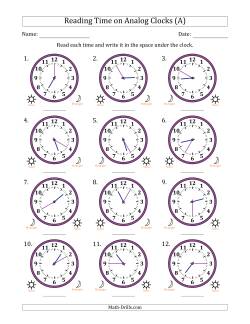
Even though the time is displayed digitally in so many places these days—on cell phones, on computers, on microwaves—there are still quite a few analog clocks around. Besides being able to tell time on an analog clock, this is probably one of the first places that students encounter a number system other than base ten. Thanks to the Babylonians et. al. we have 60 seconds in a minute and 60 minutes in an hour. Once your students master the intricacies of the time system, they can start learning about other useful number systems like hexadecimal and binary, both of which are heavily used in computer programming.
Suns and moons are included with each clock to indicate the time of day. Think of the moon as midnight and the sun as noon. If the clock has a moon (midnight) on the left and a sun (noon) on the right, then the time is between midnight and noon (AM in North America). The reverse means that the time is between noon and midnight (PM in North America).
These clock worksheets include hour and minute hands, so students who are starting to learn reading time on analog clocks only have to worry about two arms. There are a variety of intervals available depending on the level of the student. The goal is to get students to be able to tell time to the minute. There are versions with twelve clocks and versions with four large clocks.
- Reading 12 Hour Time from Clocks with Minute Hands (12 Clocks per Page) Reading 12 Hour Time in One Hour Intervals (12 Clocks) Reading 12 Hour Time in 30 Minute Intervals (12 Clocks) Reading 12 Hour Time in 15 Minute Intervals (12 Clocks) Reading 12 Hour Time in 5 Minute Intervals (12 Clocks) Reading 12 Hour Time in 1 Minute Intervals (12 Clocks)
- Reading 12 Hour Time from Clocks with Minute Hands (4 Clocks per Page) Reading 12 Hour Time in One Hour Intervals ( 4 Large Clocks ) Reading 12 Hour Time in 30 Minute Intervals ( 4 Large Clocks ) Reading 12 Hour Time in 15 Minute Intervals ( 4 Large Clocks ) Reading 12 Hour Time in 5 Minute Intervals ( 4 Large Clocks ) Reading 12 Hour Time in 1 Minute Intervals ( 4 Large Clocks )
These worksheets also include second hands in various intervals. These are best to use after students have mastered reading time to the minute. The addition of a third hand challenges them more and helps them understand how many seconds are in a minute.
- Reading 12 Hour Time from Clocks with Second Hands (12 Clocks per Page) Reading 12 Hour Time in 30 Second Intervals (12 Clocks) Reading 12 Hour Time in 15 Second Intervals (12 Clocks) Reading 12 Hour Time in 5 Second Intervals (12 Clocks) Reading 12 Hour Time in 1 Second Intervals (12 Clocks)
- Reading 12 Hour Time from Clocks with Second Hands (4 Clocks per Page) Reading 12 Hour Time in 30 Second Intervals ( 4 Large Clocks ) Reading 12 Hour Time in 15 Second Intervals ( 4 Large Clocks ) Reading 12 Hour Time in 5 Second Intervals ( 4 Large Clocks ) Reading 12 Hour Time in 1 Second Intervals ( 4 Large Clocks )
Students encounter 24 hour time in various places such as on plane tickets, in computer programming and in literature. These worksheets are similar to reading 12 hour clocks, but include a second set of numbers on the inside of the minute ticks.
- Reading 24 Hour Time from Clocks with Minute Hands (12 Clocks per Page) Reading 24 Hour Time in One Hour Intervals (12 Clocks) Reading 24 Hour Time in 30 Minute Intervals (12 Clocks) Reading 24 Hour Time in 15 Minute Intervals (12 Clocks) Reading 24 Hour Time in 5 Minute Intervals (12 Clocks) Reading 24 Hour Time in 1 Minute Intervals (12 Clocks)
- Reading 24 Hour Time from Clocks with Minute Hands (4 Clocks per Page) Reading 24 Hour Time in One Hour Intervals ( 4 Large Clocks ) Reading 24 Hour Time in 30 Minute Intervals ( 4 Large Clocks ) Reading 24 Hour Time in 15 Minute Intervals ( 4 Large Clocks ) Reading 24 Hour Time in 5 Minute Intervals ( 4 Large Clocks ) Reading 24 Hour Time in 1 Minute Intervals ( 4 Large Clocks )
These 24 hour clocks also include second hands, so students can read time represented on clocks to the nearest second.
- Reading 24 Hour Time from Clocks with Second Hands (12 Clocks per Page) Reading 24 Hour Time in 30 Second Intervals (12 Clocks) Reading 24 Hour Time in 15 Second Intervals (12 Clocks) Reading 24 Hour Time in 5 Second Intervals (12 Clocks) Reading 24 Hour Time in 1 Second Intervals (12 Clocks)
- Reading 24 Hour Time from Clocks with Second Hands (4 Clocks per Page) Reading 24 Hour Time in 30 Second Intervals ( 4 Large Clocks ) Reading 24 Hour Time in 15 Second Intervals ( 4 Large Clocks ) Reading 24 Hour Time in 5 Second Intervals ( 4 Large Clocks ) Reading 24 Hour Time in 1 Second Intervals ( 4 Large Clocks )
Once students are able to read time off of analog clocks, they can be challenged to sketch time. This might seem easy, but analog clocks tend to have a small quirk in that the hands don't always point to the exact number. For example, if it is 6:30, the hour hand will be half way between the 6 and the 7. Taking time to point this out to students will ensure they succeed on these worksheets.
- Sketching Times to Minutes on 12 Hour Analog Clocks (12 Clocks per Page) Sketching 12 Hour Time in One Hour Intervals (12 Clocks) Sketching 12 Hour Time in 30 Minute Intervals (12 Clocks) Sketching 12 Hour Time in 15 Minute Intervals (12 Clocks) Sketching 12 Hour Time in 5 Minute Intervals (12 Clocks) Sketching 12 Hour Time in 1 Minute Intervals (12 Clocks)
- Sketching Times to Minutes on 12 Hour Analog Clocks (4 Clocks per Page) Sketching 12 Hour Time in One Hour Intervals ( 4 Large Clocks ) Sketching 12 Hour Time in 30 Minute Intervals ( 4 Large Clocks ) Sketching 12 Hour Time in 15 Minute Intervals ( 4 Large Clocks ) Sketching 12 Hour Time in 5 Minute Intervals ( 4 Large Clocks ) Sketching 12 Hour Time in 1 Minute Intervals ( 4 Large Clocks )
Once students have mastered sketching in the hour and minute hands, it is time to add the second hands. As with the hour hand, the minute hand doesn't always point exactly to the minute. For example, if it is 6:30:45, the minute hand will be about 3/4 of the way to the :31 mark. If they have learned this about the hour hand already, it shouldn't be too much of a leap to get them to understand this about the minute hand.
- Sketching Times to Seconds on 12 Hour Analog Clocks (12 Clocks per Page) Sketching 12 Hour Time in 30 Second Intervals (12 Clocks) Sketching 12 Hour Time in 15 Second Intervals (12 Clocks) Sketching 12 Hour Time in 5 Second Intervals (12 Clocks) Sketching 12 Hour Time in 1 Second Intervals (12 Clocks)
- Sketching Times to Seconds on 12 Hour Analog Clocks (4 Clocks per Page) Sketching 12 Hour Time in 30 Second Intervals ( 4 Large Clocks ) Sketching 12 Hour Time in 15 Second Intervals ( 4 Large Clocks ) Sketching 12 Hour Time in 5 Second Intervals ( 4 Large Clocks ) Sketching 12 Hour Time in 1 Second Intervals ( 4 Large Clocks )
Very much the same as sketching on 12 hour clocks, these worksheets use 24 hour time.
- Sketching Times to Minutes on 24 Hour Analog Clocks (12 Clocks per Page) Sketching 24 Hour Time in One Hour Intervals (12 Clocks) Sketching 24 Hour Time in 30 Minute Intervals (12 Clocks) Sketching 24 Hour Time in 15 Minute Intervals (12 Clocks) Sketching 24 Hour Time in 5 Minute Intervals (12 Clocks) Sketching 24 Hour Time in 1 Minute Intervals (12 Clocks)
- Sketching Times to Minutes on 24 Hour Analog Clocks (4 Clocks per Page) Sketching 24 Hour Time in One Hour Intervals ( 4 Large Clocks ) Sketching 24 Hour Time in 30 Minute Intervals ( 4 Large Clocks ) Sketching 24 Hour Time in 15 Minute Intervals ( 4 Large Clocks ) Sketching 24 Hour Time in 5 Minute Intervals ( 4 Large Clocks ) Sketching 24 Hour Time in 1 Minute Intervals ( 4 Large Clocks )
- Sketching Times to Seconds on 24 Hour Analog Clocks (12 Clocks per Page) Sketching 24 Hour Time in 30 Second Intervals (12 Clocks) Sketching 24 Hour Time in 15 Second Intervals (12 Clocks) Sketching 24 Hour Time in 5 Second Intervals (12 Clocks) Sketching 24 Hour Time in 1 Second Intervals (12 Clocks)
- Sketching Times to Seconds on 24 Hour Analog Clocks (4 Clocks per Page) Sketching 24 Hour Time in 30 Second Intervals ( 4 Large Clocks ) Sketching 24 Hour Time in 15 Second Intervals ( 4 Large Clocks ) Sketching 24 Hour Time in 5 Second Intervals ( 4 Large Clocks ) Sketching 24 Hour Time in 1 Second Intervals ( 4 Large Clocks )
Converting Time
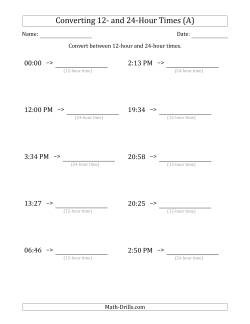
It is a very useful skill to be able to convert between 12 and 24 hour time in a global world. Even in places, like the U.S., where 12 hour time is used a lot, students still see time formatted in 24 hour time in a wide variety of situations.
- Converting Between 12- and 24-Hour Times Converting 12- to 24-Hour time Converting 24- to 12-Hour time Converting Between 12- and 24-Hour time
Converting between time units worksheets are useful to test students understanding of time measurement and to give them more practice.
- Converting Between Seconds, Minutes, Hours, Days and Weeks (one step up or down) Converting between seconds, minutes and hours (one step up or down) Converting between seconds, minutes, hours and days (one step up or down) Converting between seconds, minutes, hours, days and weeks (one step up or down)
- Converting Between Seconds, Minutes, Hours, Days and Weeks (one or two steps up or down) Converting between seconds, minutes and hours (one- or two-steps up or down) Converting between seconds, minutes, hours and days (one- or two-steps up or down) Converting between seconds, minutes, hours, days and weeks (one- or two-steps up or down)
Elapsed Time Worksheets
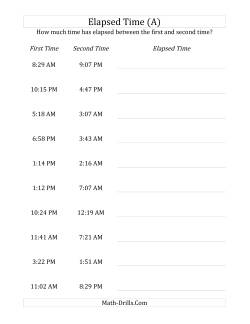
Elapsed time refers to the amount of time that has passed between a start time and a finish time. This can be challenging to students if they are not completely familiar with the base 60 system used for second, minutes and hours, and the fact that there are 24 hours a day sometimes split into morning and afternoon times.
- Elapsed Time to Minutes Elapsed Time with 1 Minute Intervals; Max 5 Hours Elapsed Time with 5 Minute Intervals; Max 5 Hours Elapsed Time with 15 Minute Intervals; Max 5 Hours Elapsed Time with 1 Minute Intervals; Max 24 Hours Elapsed Time with 5 Minute Intervals; Max 24 Hours Elapsed Time with 15 Minute Intervals; Max 24 Hours
- Elapsed Time to Seconds Elapsed Time with 1 Minute/Second Intervals; Max 5 Hours Elapsed Time with 5 Minute/Second Intervals; Max 5 Hours Elapsed Time with 15 Minute/Second Intervals; Max 5 Hours Elapsed Time with 1 Minute/Second Intervals; Max 24 Hours Elapsed Time with 5 Minute/Second Intervals; Max 24 Hours Elapsed Time with 15 Minute/Second Intervals; Max 24 Hours
The elapsed date worksheets in this section are based on a three column table with ten rows. Each different version of the elapsed date table will challenge students in different ways. The worksheets that ask students to find the end date are given a start date and an elapsed time. These worksheets work well for starting at a specific point and counting up. The worksheets that ask students to find the start date, elapsed time or the end date will have random blanks in the table, so students may have to figure out the elapsed time forwards or backwards. Below you will find various challenges including elapsed time with days only, then we progressively add weeks, months, and years to the worksheets.
Please note that when finding future dates, it is important to start with the largest unit first and progress to the smaller units. For example, if the start date is February 8, 2020 and the elapsed time is 3 years, 2 months, 3 weeks and 6 days, you would add the three years first to get February 8, 2023. Next, add the months to get April 8, 2023. Finally, add the weeks and days to get May 5, 2023. You can add the weeks and days together as they are both exact lengths whereas years and months vary in size.
- Calculate End Dates from Start Dates and Elapsed Times in Days, Weeks, Months and Years Calculate End Date for Various Elapsed Days Calculate End Date for Various Elapsed Days + Weeks Calculate End Date for Various Elapsed Days + Weeks + Months Calculate End Date for Various Elapsed Days + Weeks + Months + Years
- Calculate Elapsed Time Between Two Dates in Days, Weeks, Months and Years Calculate Elapsed Time Between Two Dates in Days Calculate Elapsed Time Between Two Dates in Days + Weeks Calculate Elapsed Time Between Two Dates in Days + Weeks + Months Calculate Elapsed Time Between Two Dates in Days + Weeks + Months + Years
- Calculate Start Dates from End Dates and Elapsed Time in Days, Weeks, Months and Years Calculate Start Date from End Date and Elapsed Time in Days Calculate Start Date from End Date and Elapsed Time in Days + Weeks Calculate Start Date from End Date and Elapsed Time in Days + Weeks + Months Calculate Start Date from End Date and Elapsed Time in Days + Weeks + Months + Years
- Calculate Various Start Dates, Elapsed Time or End Dates with Days, Weeks, Months and Years Calculate Start Date, Elapsed Time or End Date (Days) Calculate Start Date, Elapsed Time or End Date (Days + Weeks) Calculate Start Date, Elapsed Time or End Date (Days + Weeks + Months) Calculate Start Date, Elapsed Time or End Date (Days + Weeks + Months + Years)
Adding and Subtracting Time
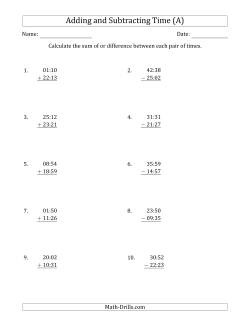
Adding and subtracting time is similar to adding any numbers, but the regrouping amounts are different. If you think of the decimal system, numbers are divided into places named: ones, tens, hundreds, etc. In time values, the places have different values based on an ancient Babylonian numbering system with a base of 60. In the "seconds place," there are 60 unique seconds from 0 to 59. The same is true for the "minutes place." The "hours place" can vary from 24 if one is interested in counting days as well, or can be greater than 24 if the largest place value is in the hours place. In these worksheets, students are challenged to regroup seconds and minutes as they add or subtract two time amounts.
- Adding and Subtracting Hours and Minutes Adding Hours and Minutes (Compact Format) Adding Hours and Minutes (Long Format) Subtracting Hours and Minutes (Compact Format) Subtracting Hours and Minutes (Long Format) Adding and Subtracting Hours and Minutes (Compact Format) Adding and Subtracting Hours and Minutes (Long Format)
- Adding and Subtracting Hours, Minutes and Seconds Adding Hours, Minutes and Seconds (Compact Format) Adding Hours, Minutes and Seconds (Long Format) Subtracting Hours, Minutes and Seconds (Compact Format) Subtracting Hours, Minutes and Seconds (Long Format) Adding and Subtracting Hours, Minutes and Seconds (Compact Format) Adding and Subtracting Hours, Minutes and Seconds (Long Format)
Copyright © 2005-2024 Math-Drills.com You may use the math worksheets on this website according to our Terms of Use to help students learn math.

Time Calculations Textbook Exercise
Click here for questions, gcse revision cards.

5-a-day Workbooks

Primary Study Cards

Privacy Policy
Terms and Conditions
Corbettmaths © 2012 – 2024
- Skills by Standard
- Skills by Grade
- Skills by Category
Go to profile
- Assignments
- Assessments
- Report Cards
- Our Teachers
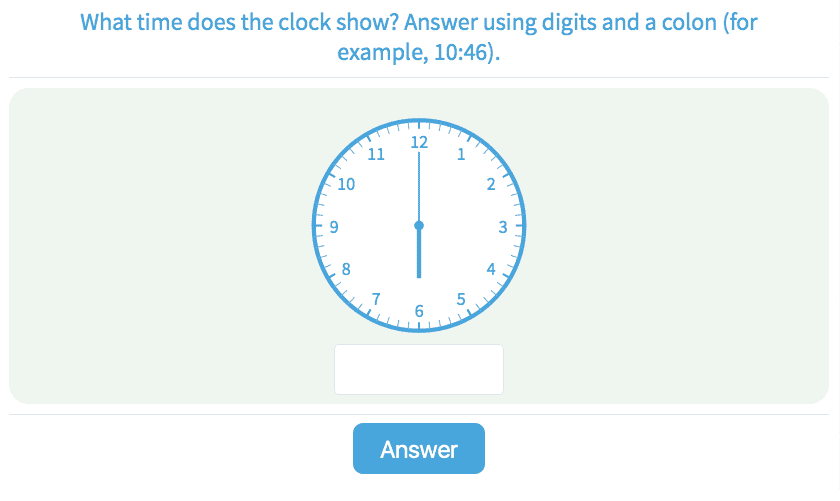
Common Core - State Standards Initiative
Telling the time and keeping track of time are activities that adults have to do on a daily basis. With Math Games, you can make sure that the kids in your life develop and practice this skill as much as they need, while they have fun playing our free educational games!
Students can play our exciting games on a cellphone, tablet or computer, to practice:
- Reading and comparing clocks
- Using correct time units
- Calculating changes in time
- Working out start times, end times and elapsed time
Math Games encourages children to look forward to learning and reviewing math. Our site also provides additional (and free!) instructional resources, such as printable worksheets, student progress reports, a digital textbook, and downloadable apps for mobile devices. Have a look around to see how we can meet your needs!
Special April offer - 7 days free unlimited access to all premium content Try Premium
- Interactive
Time Word Problems
Time word problems interactive.

Filter by Grade:
Filter by subject:.

Reading & Math for K-5
- Kindergarten
- Learning numbers
- Comparing numbers
- Place Value
- Roman numerals
- Subtraction
- Multiplication
- Order of operations
- Drills & practice
- Measurement
- Factoring & prime factors
- Proportions
- Shape & geometry
- Data & graphing
- Word problems
- Children's stories
- Leveled Stories
- Context clues
- Cause & effect
- Compare & contrast
- Fact vs. fiction
- Fact vs. opinion
- Main idea & details
- Story elements
- Conclusions & inferences
- Sounds & phonics
- Words & vocabulary
- Reading comprehension
- Early writing
- Numbers & counting
- Simple math
- Social skills
- Other activities
- Dolch sight words
- Fry sight words
- Multiple meaning words
- Prefixes & suffixes
- Vocabulary cards
- Other parts of speech
- Punctuation
- Capitalization
- Narrative writing
- Opinion writing
- Informative writing
- Cursive alphabet
- Cursive letters
- Cursive letter joins
- Cursive words
- Cursive sentences
- Cursive passages
- Grammar & Writing
Breadcrumbs
- Math by topic
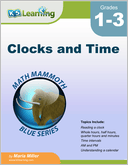
Download & Print Only $5.30
Time Worksheets
Time and calendar worksheets.
Our time worksheets review the units of time (seconds vs minutes ...) and then focus on telling time : the reading of clocks. These worksheets also cover elapsed time ( What time will it be in 3 hours? ), am/pm, the days of the week and reading calendars.
Choose your grade / topic:
Grade 1 time worksheets, grade 2 time worksheets, grade 3 time worksheets.
Topics include:
- Units of time (seconds, minutes, hours, days)
- Drawing time on a clock (whole hours, half hours, quarter hours)
- Tell the time (whole hours, half hours, quarter hours)
- Elapsed time (whole hours)
- Word problems: time & elapsed time (whole hours)
- Units of time
- Drawing time on a clock (whole hours, half hours, quarter hours, 5 and 1 minute intervals)
- Tell the time (whole hours, half hours, quarter hours, 5 and 1 minute intervals)
- Elapsed time (forward / backward, whole hours & half hours)
- Clock or calendar?
- Days of the week
- Months of the year
- Time word problems (1/2 hours, 5 min)
- Time phrases (e.g. "ten past 8")
- Draw the clock (5 and 1 minute intervals)
- Telling time (5 and 1 minute intervals)
- Elapsed time (forward / backward, 5 and 1 minute intervals)
- Estimating and rounding time
- Converting units of time (years, months .... seconds)
- Reading a calendar
- Months as ordinal numbers
- Writing dates
- Elapsed time on a calendar
- Time word problems
Grade 4 time worksheets
Related topics.
Measurement worksheets
Money worksheets

Sample Time Worksheet
What is K5?
K5 Learning offers free worksheets , flashcards and inexpensive workbooks for kids in kindergarten to grade 5. Become a member to access additional content and skip ads.

Our members helped us give away millions of worksheets last year.
We provide free educational materials to parents and teachers in over 100 countries. If you can, please consider purchasing a membership ($24/year) to support our efforts.
Members skip ads and access exclusive features.
Learn about member benefits
This content is available to members only.
Join K5 to save time, skip ads and access more content. Learn More
- Forgot Password?
Example 1: Convert 300 minutes to hours.
There are 60 minutes in every hour. To convert from minutes to hours we need to divide by 60. 300 ÷ 60 300 ÷ 60 is the same as 30 ÷ 6 (this is like simplifying a fraction) 30 ÷ 6 = 5 There are 5 hours in 300 minutes.
Example 2: Convert 7 hours to minutes.
There are 60 minutes in every hour. To convert from hours to minutes we need to multiply by 60. 7 × 60 7 × 60 = 420 There are 420 minutes in 7 hours.
Example 3: Convert 281 minutes to hours. Give your answer in hours and minutes.
There are 60 minutes in every hour. We can write down the 60 times table to see how many whole hours are in 281 minutes.
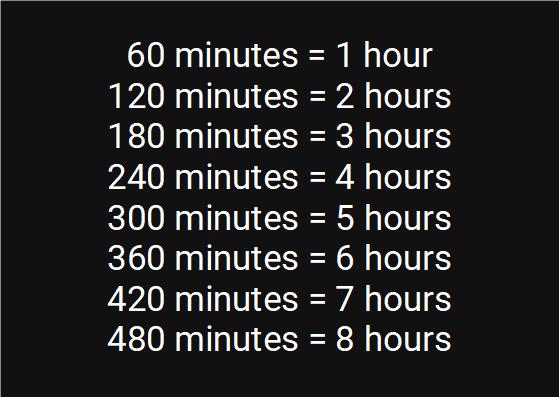
4 hours = 240 minutes There are 4 whole hours in 281 minutes. We can calculate how many additional minutes there are by taking 240 away from 281 281 - 240 = 41 281 minutes = 4 hours and 41 minutes.
Example 4: A film starts at 7:50 pm and runs for 89 minutes. Work out the time when the film ends.
There are 60 minutes in every hour. We need 10 minutes to get to the next hour (8 pm). 89 - 10 = 79 (there are 79 minutes of film left) Another 60 minutes will get to 9 pm. 79 -60 = 19 (there are 19 minutes of the film left)
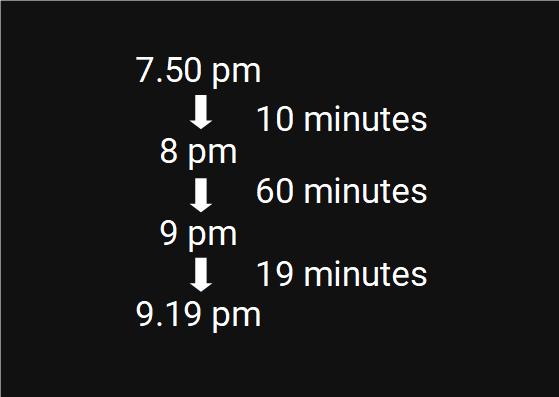
9pm + 19 minutes = 9.19 pm

Or search by topic
Number and algebra
- The Number System and Place Value
- Calculations and Numerical Methods
- Fractions, Decimals, Percentages, Ratio and Proportion
- Properties of Numbers
- Patterns, Sequences and Structure
- Algebraic expressions, equations and formulae
- Coordinates, Functions and Graphs
Geometry and measure
- Angles, Polygons, and Geometrical Proof
- 3D Geometry, Shape and Space
- Measuring and calculating with units
- Transformations and constructions
- Pythagoras and Trigonometry
- Vectors and Matrices
Probability and statistics
- Handling, Processing and Representing Data
- Probability
Working mathematically
- Thinking mathematically
- Mathematical mindsets
- Cross-curricular contexts
- Physical and digital manipulatives
For younger learners
- Early Years Foundation Stage
Advanced mathematics
- Decision Mathematics and Combinatorics
- Advanced Probability and Statistics
This collection is one of our Primary Curriculum collections - tasks that are grouped by topic.
Watch the Clock
During the third hour after midnight the hands on a clock point in the same direction (so one hand is over the top of the other). At what time, to the nearest second, does this happen?
How Many Times?
On a digital 24 hour clock, at certain times, all the digits are consecutive. How many times like this are there between midnight and 7 a.m.?
Wonky Watches
Stuart's watch loses two minutes every hour. Adam's watch gains one minute every hour. Use the information to work out what time (the real time) they arrived at the airport.
These clocks have been reflected in a mirror. What times do they say?
The Time Is ...
Can you put these mixed-up times in order? You could arrange them in a circle.
5 on the Clock
On a digital clock showing 24 hour time, over a whole day, how many times does a 5 appear? Is it the same number for a 12 hour clock over a whole day?
These clocks have only one hand, but can you work out what time they are showing from the information?

Approaching Midnight Live
Here's a strategy game with lots to explore. Can you find out enough to guarantee a win, no matter what the settings?

TIME AND WORK PROBLEMS
1. If a person can do a piece of work in ‘m’ days, he can do ¹⁄ m part of the work in 1 day.
2. If the number of persons engaged to do a piece of work be increased (or decreased) in a certain ratio the time required to do the same work will be decreased (or increased) in the same ratio.
3. If A is twice as good a workman as B, then A will take half the time taken by B to do a certain piece of work.
4. Time and work are always in direct proportion.
more work ----> more time
less work ----> less time
5. A takes m days and B takes n days to complete a work. If they work together, then the formula to find the number of days taken by them to complete the work is
Problem 1 :
A can do a piece of work in 15 days while B can do it in 10 days. How long will they take together to do it?
Using the above formula, if they work together, number of days taken to complete the work is
Problem 2 :
A and B can complete a work in 6 days . B and C can complete the same work in 8 days. C and A can complete in 12 days. How many days will take for A, B and C combined together to complete the same amount of work ?
From the given information, we can have
(A + B)'s 1 day work = ⅙
(B + C)'s 1 day work = ⅛
(A + C)'s 1 day work = ¹⁄₁₂
(A + B + B + C + A + C)'s 1 day work = ⅙ + ⅛ + ¹⁄₁₂
(2A + 2B + 2C)'s 1 day work = ⅙ + ⅛ + ¹⁄₁₂
2 ⋅ (A + B + C)'s 1 day work = ⅙ + ⅛ + ¹⁄₁₂
L.C.M of (6, 8, 12) = 24.
2 (A + B + C)'s 1 day work = ⁴⁄₂₄ + ³⁄₂₄ + ²⁄₂₄
2 (A + B + C)'s 1 day work = ⁹⁄₂₄
2 (A + B + C)'s 1 day work = ⅜
(A + B + C)'s 1 day work = ³⁄₁₆
Time taken by A, B and C together to complete the work is
= 5 ⅓ days
Problem 3 :
A and B can do a work in 15 days, B and C in 30 days and A and C in 18 days. They work together for 9 days and then A left. In how many more days, can B and C finish the remaining work ?
(A + B)'s 1 day work = ¹⁄₁₅
(B + C)'s 1 day work = ¹⁄₃₀
(A + C)'s 1 day work = ¹⁄₁₈
(A + B + B + C + A + C)'s 1 day work = ¹⁄₁₅ + ¹⁄₃₀ + ¹⁄₁₈
(2A + 2B + 2C)'s 1 day work = ¹⁄₁₅ + ¹⁄₃₀ + ¹⁄₁₈
2 (A + B + C)'s 1 day work = ¹⁄₁₅ + ¹⁄₃₀ + ¹⁄₁₈
L.C.M of (15, 30, 18) = 90.
2 (A + B + C)'s 1 day work = ⁶⁄₉₀ + ³⁄₉₀ + ⁵⁄₉₀
2 (A + B + C)'s 1 day work = ¹⁴⁄₉₀
2 (A + B + C)'s 1 day work = ⁷⁄₄₅
(A + B + C)'s 1 day work = ⁷⁄₉₀
Then, the amount of work completed by A, B and C together in 9 days is
= 9 ⋅ ⁷⁄₉₀
= ⁷⁄₁₀
Amount of work left for B and C to complete is
= ³⁄₁₀
Number of days that B will take to finish the work is
= amount of work/part of the work done in 1 day
= ³⁄₁₀ ÷ ¹⁄₃₀
= ³⁄₁₀ ⋅ ³⁰⁄₁
Problem 4 :
A contractor decided to complete the work in 90 days and employed 50 men at the beginning and 20 men additionally after 20 days and got the work completed as per schedule. If he had not employed the additional men, how many extra days would he have needed to complete the work?
The work has to completed in 90 days (as per schedule).
Total no. of men appointed initially = 50.
Given : 50 men have already worked for 20 days and completed a part of the work.
If the remaining work is done by 70 men (50 + 20 = 70), the work can be completed in 70 days and the total work can be completed in 90 days as per the schedule.
Let 'x' be the no. of days required when the remaining work is done by 50 men.
For the remaining work,
70 men ----> 70 days
50 men -----> x days
The above one is a inverse variation.
Because, when no. of men is decreased, no. of days will be increased.
By inverse variation, we have
70 ⋅ 70 = 50 ⋅ x
So, if the remaining work is done by 50 men, it can be completed in 98 days.
So, extra days needed = 98 - 70 = 28 days.
Problem 5 :
Three taps A, B and C can fill a tank in 10, 15 and 20 hours respectively. If A is open all the time and B and C are open for one hour each alternately, find the time taken to fill the tank.
A's 1 hour work = ⅒
B's 1 hour work = ¹⁄₁₅
C's 1 hour work = ¹⁄₂₀
In the first hour, we have
(A + B)'s work = ⅒ + ¹⁄₁₅
(A + B)'s work = ³⁄₃₀ + ²⁄₃₀
(A + B)'s work = ⁵⁄₃₀
(A + B)'s work = ⅙
In the second hour, we have
(A + C)'s work = ⅒ + ¹⁄₂₀
(A + C)'s work = ²⁄₂₀ + ¹⁄₂₀
(A + C)'s work = ³⁄₂₀
Amount of work done in each two hours is
= ¹⁰⁄₆₀ + ⁹⁄₆₀
Amount of work done :
In the first 2 hours : ¹⁹⁄₆₀
In the first 4 hours : ¹⁹⁄₆₀ + ¹⁹⁄₆₀ = ³⁸⁄₆₀
In the first 6 hours : ¹⁹⁄₆₀ + ¹⁹⁄₆₀ + ¹⁹⁄₆₀ = ⁵⁷⁄₆₀
After 6 hours, the remaining work will be
= ¹⁄₂₀
¹⁄₂₀ is the small amount of work left and A alone can complete this.
Time taken by A to complete this 1/20 part of the work is
= amount of work/part of work done in 1 hour
= ¹⁄₂₀ ÷ ⅒
= ¹⁄₂₀ ⋅ ¹⁰⁄₁
= ½ hours
So, A will will take half an hour (or 30 minutes) to complete the remaining work ¹⁄₂₀ .
So, total time taken to complete the work is
= 6 hours + 30 minutes
= 6 ½ hours
Kindly mail your feedback to [email protected]
We always appreciate your feedback.
© All rights reserved. onlinemath4all.com
- Sat Math Practice
- SAT Math Worksheets
- PEMDAS Rule
- BODMAS rule
- GEMDAS Order of Operations
- Math Calculators
- Transformations of Functions
- Order of rotational symmetry
- Lines of symmetry
- Compound Angles
- Quantitative Aptitude Tricks
- Trigonometric ratio table
- Word Problems
- Times Table Shortcuts
- 10th CBSE solution
- PSAT Math Preparation
- Privacy Policy
- Laws of Exponents
Recent Articles
Finding Vertex of a Quadratic Function Worksheet
Apr 27, 24 11:06 AM

Writing Quadratic Functions in Standard Form Worksheet
Apr 27, 24 12:26 AM
Writing Quadratic Functions in Standard Form
Apr 27, 24 12:13 AM
High Impact Tutoring Built By Math Experts
Personalized standards-aligned one-on-one math tutoring for schools and districts
Free ready-to-use math resources
Hundreds of free math resources created by experienced math teachers to save time, build engagement and accelerate growth

20 Effective Math Strategies To Approach Problem-Solving
Katie Keeton
Math strategies for problem-solving help students use a range of approaches to solve many different types of problems. It involves identifying the problem and carrying out a plan of action to find the answer to mathematical problems.
Problem-solving skills are essential to math in the general classroom and real-life. They require logical reasoning and critical thinking skills. students must be equipped with strategies to help them find solutions to problems.
This article explores mathematical problem solving strategies, logical reasoning and critical thinking skills to help learners with solving math word problems independently in real-life situations.
What are problem-solving strategies?
Problem-solving strategies in math are methods students can use to figure out solutions to math problems. Some problem-solving strategies:
- Draw a model
- Use different approaches
- Check the inverse to make sure the answer is correct
Students need to have a toolkit of math problem-solving strategies at their disposal to provide different ways to approach math problems. This makes it easier to find solutions and understand math better.
Strategies can help guide students to the solution when it is difficult ot know when to start.

The ultimate guide to problem solving techniques
Download these ready-to-go problem solving techniques that every student should know. Includes printable tasks for students including challenges, short explanations for teachers with questioning prompts.
20 Math Strategies For Problem-Solving
Different problem-solving math strategies are required for different parts of the problem. It is unlikely that students will use the same strategy to understand and solve the problem.
Here are 20 strategies to help students develop their problem-solving skills.
Strategies to understand the problem
Strategies that help students understand the problem before solving it helps ensure they understand:
- The context
- What the key information is
- How to form a plan to solve it
Following these steps leads students to the correct solution and makes the math word problem easier .
Here are five strategies to help students understand the content of the problem and identify key information.
1. Read the problem aloud
Read a word problem aloud to help understand it. Hearing the words engages auditory processing. This can make it easier to process and comprehend the context of the situation.
2. Highlight keywords
When keywords are highlighted in a word problem, it helps the student focus on the essential information needed to solve it. Some important keywords help determine which operation is needed. For example, if the word problem asks how many are left, the problem likely requires subtraction. Ensure students highlight the keywords carefully and do not highlight every number or keyword. There is likely irrelevant information in the word problem.
3. Summarize the information
Read the problem aloud, highlight the key information and then summarize the information. Students can do this in their heads or write down a quick summary. Summaries should include only the important information and be in simple terms that help contextualize the problem.
4. Determine the unknown
A common problem that students have when solving a word problem is misunderstanding what they are solving. Determine what the unknown information is before finding the answer. Often, a word problem contains a question where you can find the unknown information you need to solve. For example, in the question ‘How many apples are left?’ students need to find the number of apples left over.
5. Make a plan
Once students understand the context of the word problem, have dentified the important information and determined the unknown, they can make a plan to solve it. The plan will depend on the type of problem. Some problems involve more than one step to solve them as some require more than one answer. Encourage students to make a list of each step they need to take to solve the problem before getting started.
Strategies for solving the problem
1. draw a model or diagram.
Students may find it useful to draw a model, picture, diagram, or other visual aid to help with the problem solving process. It can help to visualize the problem to understand the relationships between the numbers in the problem. In turn, this helps students see the solution.

Similarly, you could draw a model to represent the objects in the problem:

2. Act it out
This particular strategy is applicable at any grade level but is especially helpful in math investigation in elementary school . It involves a physical demonstration or students acting out the problem using movements, concrete resources and math manipulatives . When students act out a problem, they can visualize and contectualize the word problem in another way and secure an understanding of the math concepts. The examples below show how 1st-grade students could “act out” an addition and subtraction problem:
3. Work backwards
Working backwards is a popular problem-solving strategy. It involves starting with a possible solution and deciding what steps to take to arrive at that solution. This strategy can be particularly helpful when students solve math word problems involving multiple steps. They can start at the end and think carefully about each step taken as opposed to jumping to the end of the problem and missing steps in between.
For example,

To solve this problem working backwards, start with the final condition, which is Sam’s grandmother’s age (71) and work backwards to find Sam’s age. Subtract 20 from the grandmother’s age, which is 71. Then, divide the result by 3 to get Sam’s age. 71 – 20 = 51 51 ÷ 3 = 17 Sam is 17 years old.
4. Write a number sentence
When faced with a word problem, encourage students to write a number sentence based on the information. This helps translate the information in the word problem into a math equation or expression, which is more easily solved. It is important to fully understand the context of the word problem and what students need to solve before writing an equation to represent it.
5. Use a formula
Specific formulas help solve many math problems. For example, if a problem asks students to find the area of a rug, they would use the area formula (area = length × width) to solve. Make sure students know the important mathematical formulas they will need in tests and real-life. It can help to display these around the classroom or, for those who need more support, on students’ desks.
Strategies for checking the solution
Once the problem is solved using an appropriate strategy, it is equally important to check the solution to ensure it is correct and makes sense.
There are many strategies to check the solution. The strategy for a specific problem is dependent on the problem type and math content involved.
Here are five strategies to help students check their solutions.
1. Use the Inverse Operation
For simpler problems, a quick and easy problem solving strategy is to use the inverse operation. For example, if the operation to solve a word problem is 56 ÷ 8 = 7 students can check the answer is correct by multiplying 8 × 7. As good practice, encourage students to use the inverse operation routinely to check their work.
2. Estimate to check for reasonableness
Once students reach an answer, they can use estimation or rounding to see if the answer is reasonable. Round each number in the equation to a number that’s close and easy to work with, usually a multiple of ten. For example, if the question was 216 ÷ 18 and the quotient was 12, students might round 216 to 200 and round 18 to 20. Then use mental math to solve 200 ÷ 20, which is 10. When the estimate is clear the two numbers are close. This means your answer is reasonable.
3. Plug-In Method
This method is particularly useful for algebraic equations. Specifically when working with variables. To use the plug-in method, students solve the problem as asked and arrive at an answer. They can then plug the answer into the original equation to see if it works. If it does, the answer is correct.

If students use the equation 20m+80=300 to solve this problem and find that m = 11, they can plug that value back into the equation to see if it is correct. 20m + 80 = 300 20 (11) + 80 = 300 220 + 80 = 300 300 = 300 ✓
4. Peer Review
Peer review is a great tool to use at any grade level as it promotes critical thinking and collaboration between students. The reviewers can look at the problem from a different view as they check to see if the problem was solved correctly. Problem solvers receive immediate feedback and the opportunity to discuss their thinking with their peers. This strategy is effective with mixed-ability partners or similar-ability partners. In mixed-ability groups, the partner with stronger skills provides guidance and support to the partner with weaker skills, while reinforcing their own understanding of the content and communication skills. If partners have comparable ability levels and problem-solving skills, they may find that they approach problems differently or have unique insights to offer each other about the problem-solving process.
5. Use a Calculator
A calculator can be introduced at any grade level but may be best for older students who already have a foundational understanding of basic math operations. Provide students with a calculator to allow them to check their solutions independently, accurately, and quickly. Since calculators are so readily available on smartphones and tablets, they allow students to develop practical skills that apply to real-world situations.
Step-by-step problem-solving processes for your classroom
In his book, How to Solve It , published in 1945, mathematician George Polya introduced a 4-step process to solve problems.
Polya’s 4 steps include:
- Understand the problem
- Devise a plan
- Carry out the plan
Today, in the style of George Polya, many problem-solving strategies use various acronyms and steps to help students recall.
Many teachers create posters and anchor charts of their chosen process to display in their classrooms. They can be implemented in any elementary, middle school or high school classroom.
Here are 5 problem-solving strategies to introduce to students and use in the classroom.

How Third Space Learning improves problem-solving
Resources .
Third Space Learning offers a free resource library is filled with hundreds of high-quality resources. A team of experienced math experts carefully created each resource to develop students mental arithmetic, problem solving and critical thinking.
Explore the range of problem solving resources for 2nd to 8th grade students.
One-on-one tutoring
Third Space Learning offers one-on-one math tutoring to help students improve their math skills. Highly qualified tutors deliver high-quality lessons aligned to state standards.
Former teachers and math experts write all of Third Space Learning’s tutoring lessons. Expertly designed lessons follow a “my turn, follow me, your turn” pedagogy to help students move from guided instruction and problem-solving to independent practice.
Throughout each lesson, tutors ask higher-level thinking questions to promote critical thinking and ensure students are developing a deep understanding of the content and problem-solving skills.

Problem-solving
Educators can use many different strategies to teach problem-solving and help students develop and carry out a plan when solving math problems. Incorporate these math strategies into any math program and use them with a variety of math concepts, from whole numbers and fractions to algebra.
Teaching students how to choose and implement problem-solving strategies helps them develop mathematical reasoning skills and critical thinking they can apply to real-life problem-solving.
READ MORE : 8 Common Core math examples
There are many different strategies for problem-solving; Here are 5 problem-solving strategies: • draw a model • act it out • work backwards • write a number sentence • use a formula
Here are 10 strategies of problem-solving: • Read the problem aloud • Highlight keywords • Summarize the information • Determine the unknown • Make a plan • Draw a model • Act it out • Work backwards • Write a number sentence • Use a formula
1. Understand the problem 2. Devise a plan 3. Carry out the plan 4. Look back
Some strategies you can use to solve challenging math problems are: breaking the problem into smaller parts, using diagrams or models, applying logical reasoning, and trying different approaches.
Related articles

Why Student Centered Learning Is Important: A Guide For Educators

13 Effective Learning Strategies: A Guide to Using them in your Math Classroom

Differentiated Instruction: 9 Differentiated Curriculum And Instruction Strategies For Teachers

5 Math Mastery Strategies To Incorporate Into Your 4th and 5th Grade Classrooms
Ultimate Guide to Metacognition [FREE]
Looking for a summary on metacognition in relation to math teaching and learning?
Check out this guide featuring practical examples, tips and strategies to successfully embed metacognition across your school to accelerate math growth.
Privacy Overview

Get step-by-step solutions to your math problems

Try Math Solver

Get step-by-step explanations

Graph your math problems

Practice, practice, practice

Get math help in your language
Math Solver
Geogebra math solver.
Get accurate solutions and step-by-step explanations for algebra and other math problems, while enhancing your problem-solving skills!

3 Ways to Strengthen Math Instruction

- Share article
Students’ math scores have plummeted, national assessments show , and educators are working hard to turn math outcomes around.
But it’s a challenge, made harder by factors like math anxiety , students’ feelings of deep ambivalence about how math is taught, and learning gaps that were exacerbated by the pandemic’s disruption of schools.
This week, three educators offered solutions on how districts can turn around poor math scores in a conversation moderated by Peter DeWitt, an opinion blogger for Education Week.
Here are three takeaways from the discussion. For more, watch the recording on demand .
1. Intervention is key
Research shows that early math skills are a key predictor of later academic success.
“Children who know more do better, and math is cumulative—so if you don’t grasp some of the earlier concepts, math gets increasingly harder,” said Nancy Jordan, a professor of education at the University of Delaware.
For example, many students struggle with the concept of fractions, she said. Her research has found that by 6th grade, some students still don’t really understand what a fraction is, which makes it harder for them to master more advanced concepts, like adding or subtracting fractions with unlike denominators.
At that point, though, teachers don’t always have the time in class to re-teach those basic or fundamental concepts, she said, which is why targeted intervention is so important.

Still, Jordan’s research revealed that in some middle schools, intervention time is not a priority: “If there’s an assembly, or if there is a special event or whatever, it takes place during intervention time,” she said. “Or ... the children might sit on computers, and they’re not getting any really explicit instruction.”
2. ‘Gamify’ math class
Students today need new modes of instruction that meet them where they are, said Gerilyn Williams, a math teacher at Pinelands Regional Junior High School in Little Egg Harbor Township, N.J.
“Most of them learn through things like TikTok or YouTube videos,” she said. “They like to play games, they like to interact. So how can I bring those same attributes into my lesson?”
Part of her solution is gamifying instruction. Williams avoids worksheets. Instead, she provides opportunities for students to practice skills that incorporate elements of game design.
That includes digital tools, which provide students with the instant feedback they crave, she said.
But not all the games are digital. Williams’ students sometimes play “trashketball,” a game in which they work in teams to answer math questions. If they get the question right, they can crumble the piece of paper and throw it into a trash can from across the room.
“The kids love this,” she said.

Williams also incorporates game-based vocabulary into her instruction, drawing on terms from video games.
For example, “instead of calling them quizzes and tests, I call them boss battles,” she said. “It’s less frightening. It reduces that math anxiety, and it makes them more engaging.
“We normalize things like failure, because when they play video games, think about what they’re doing,” Williams continued. “They fail—they try again and again and again and again until they achieve success.”
3. Strengthen teacher expertise
To turn around math outcomes, districts need to invest in teacher professional development and curriculum support, said Chaunté Garrett, the CEO of ELLE Education, which partners with schools and districts to support student learning.
“You’re not going to be able to replace the value of a well-supported and well-equipped mathematics teacher,” she said. “We also want to make sure that that teacher has a math curriculum that’s grounded in the standards and conceptually based.”
Students will develop more critical thinking skills and better understand math concepts if teachers are able to relate instruction to real life, Garrett said—so that “kids have relationships that they can pull on, and math has some type of meaning and context to them outside of just numbers and procedures.”

It’s important for math curriculum to be both culturally responsive and relevant, she added. And teachers might need training on how to offer opportunities for students to analyze and solve real-world problems.
“So often, [in math problems], we want to go back to soccer and basketball and all of those things that we lived through, and it’s not that [current students] don’t enjoy those, but our students live social media—they literally live it,” Garrett said. “Those are the things that have to live out in classrooms right now, and if we’re not doing those things, we are doing a disservice.”
Sign Up for EdWeek Update
Edweek top school jobs.

Sign Up & Sign In


IMAGES
VIDEO
COMMENTS
The printable time sheets in this section involve being able to tell the time to the nearest minute, as well as converting times between the 12 and 24 clock. These worksheets are great to use when your child is confident telling the time and needs to extend their knowledge by solving time problems.
Time - Word problems - Worksheet #4. POPULAR TAGS : Free worksheets for time word problems, Time Word Problems Worksheets, PDF For Time Word Problems. Improve your kids math knowledge with free questions in "time word problems" and thousands of other math skills. Get all the worksheets here!
Here are our collection of clock worksheets for 2nd grade. These sheets cover telling the time for quarter past and quarter to times. Using these second grade math worksheets will help your child to: read quarter past and quarter to times; convert analogue to digital times; draw clock hands in the correct place for quarter past and quarter to.
20 Elapsed Time Word Problems. Elapsed time is the amount of time that passes between the beginning and the end of an event. The concept of elapsed time fits nicely in the elementary school curriculum. Beginning in third grade, students should be able to tell and write time to the nearest minute and solve word problems involving addition and ...
Time Word Problem 1: The Sailboat Race. In a sailboat race, the winning boat completed two distances in the following times: 2 min 22 seconds and 3 min 45 seconds. How much time did it take the sailboat to finish from the beginning to the end? We want to know the total time that it took for the sailboat to finish.
Telling time word problems. Google Classroom. Jay works on building a tree house for 1 hour and 30 minutes. He finishes working at 9: 00 a.m. Which number line below graphs when Jay starts working on the tree house? Choose 1 answer: 9: 00 9: 30 10: 00 10: 30 11: 00. A. 9: 00 9: 30 10: 00 10: 30 11: 00.
Welcome to the time worksheets page at Math-Drills.com where taking your time is encouraged! On this page you will find Time math worksheets including elapsed time, telling time on analog clocks, calendars and converting time worksheets.. The calendars come in two different formats: yearly (all on one page) and monthly when you need extra space or a larger layout.
Next: Product Rule for Counting Practice Questions GCSE Revision Cards. 5-a-day Workbooks
Below are three versions of our grade 4 math worksheet with word problems involving time and elapsed time. Students must figure out what time it was, will be or how much time went by in the various scenarios described. Use of "am" and "pm" is emphasized. These worksheets are pdf files. Worksheet #1 Worksheet #2 Worksheet #3 Worksheet #4.
Time word problem: travel time. Video 1 minute 30 seconds 1:30. Time word problem: puzzle. Report a problem. ... Learn for free about math, art, computer programming, economics, physics, chemistry, biology, medicine, finance, history, and more. Khan Academy is a nonprofit with the mission of providing a free, world-class education for anyone ...
Well, you have 15 minutes in the "4-hour," so I subtract that from 20 minutes, leaving us with 5 minutes. Now we have to go back to the "3-hour" because we have no more time in the "4-hour." The "3-hour" has 60 minutes, so we get 55 minutes when we subtract the 5 we had left. This means you have to leave at.
With Math Games, you can make sure that the kids in your life develop and practice this skill as much as they need, while they have fun playing our free educational games! Students can play our exciting games on a cellphone, tablet or computer, to practice: Reading and comparing clocks. Using correct time units. Calculating changes in time.
Our time puzzles will help encourage your child to think about time, solve problems involving time, and develop an understanding of the language used in time. Over 4,500 free worksheets available to learn and practice math. Designed by experts and adapted to the demands of each country and school grade.
Grade 3 time worksheets. Time phrases (e.g. "ten past 8") Draw the clock (5 and 1 minute intervals) Telling time (5 and 1 minute intervals) Elapsed time (forward / backward, 5 and 1 minute intervals) Estimating and rounding time. Converting units of time (years, months .... seconds) Reading a calendar. Months as ordinal numbers.
Time word problems for year 4. When solving time word problems for year 4, pupils need to be confident telling time in analogue, and digital, as well as converting between analogue, 12 hour and 24 hour clock. They also begin to solve more challenging problems involving duration of time and converting time.
A Problem of Time. Consider a watch face which has identical hands and identical marks for the hours. It is opposite to a mirror. When is the time as read direct and in the mirror exactly the same between 6 and 7?
A film starts at 7:50 pm and runs for 89 minutes. Work out the time when the film ends. There are 60 minutes in every hour. 9pm + 19 minutes = 9.19 pm. Try these: A film starts at 8.15 pm and runs for 115 minutes. Work out the time when the films ends. A film starts at 6.56 pm and runs for 85 minutes.
This math video tutorial focuses on solving work and time problems using simple tricks and shortcuts. It contains a simple formula that you can use with the...
Watch the Clock. Age 7 to 11. Challenge Level. During the third hour after midnight the hands on a clock point in the same direction (so one hand is over the top of the other). At what time, to the nearest second, does this happen?
TIME AND WORK PROBLEMS. 1. If a person can do a piece of work in 'm' days, he can do ¹⁄m part of the work in 1 day. 2. If the number of persons engaged to do a piece of work be increased (or decreased) in a certain ratio the time required to do the same work will be decreased (or increased) in the same ratio. 3.
KS2 The Year 3000 Calendar - Maths Mastery Problems. Ghostbusters: Time and Duration Problem Solving Challenge Cards [Ages 7-9] 5.0 (1 review) Sonic: Time Challenges [Ages 9-11] 4.7 (3 reviews) Year 5 Measurement Solve Problems Converting Time Maths Mastery Challenge Cards. 4.2 (5 reviews) Scuderia Ferrari F1: Time Problems Interactive Quiz.
Improve your math knowledge with free questions in "Calculate speed, distance, or time: word problems" and thousands of other math skills.
Hundreds of free math resources created by experienced math teachers to save time, build engagement and accelerate growth Explore all resources Contents. ... Math strategies for problem-solving help students use a range of approaches to solve many different types of problems. It involves identifying the problem and carrying out a plan of action ...
Get math help in your language. Works in Spanish, Hindi, German, and more. Online math solver with free step by step solutions to algebra, calculus, and other math problems. Get help on the web or with our math app.
Get accurate solutions and step-by-step explanations for algebra and other math problems with the free GeoGebra Math Solver. Enhance your problem-solving skills while learning how to solve equations on your own. Try it now!
Learn for free about math, art, computer programming, economics, physics, chemistry, biology, medicine, finance, history, and more. ... Time word problem: Susan's break. Time conversion word problems. Converting units of time review (seconds, minutes, & hours) Math > 4th grade > Units of measurement >
Here are three takeaways from the discussion. For more, watch the recording on demand. 1. Intervention is key. Research shows that early math skills are a key predictor of later academic success.
A bipartisan, bicameral group has honed in on the notices millions get in their mailboxes annually when the IRS makes adjustments to returns with simple math or clerical fixes. The problem is that ...
They can also help improve students' math test scores and build their mathematical skills over time. Let's look at some of the best math AI tools for mathematical problem-solving: ... With Caktus.AI's user-friendly interface and intelligent problem-solving skills, users can confidently overcome mathematical obstacles including algebraic ...
AI startup Edia is guaranteeing improved math outcomes for students in grades 6-12 within a year, offering a full refund if results aren't met. ... Armed with this real-time, predictive data ...